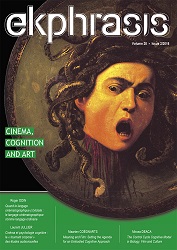Spectator Perspectives in Virtual Reality Cinematography.
The Witness, the Hero and the Impersonator
Spectator Perspectives in Virtual Reality Cinematography.
The Witness, the Hero and the Impersonator
Author(s): Dana Florentina NicolaeSubject(s): Fine Arts / Performing Arts
Published by: Universitatea Babeş-Bolyai, Facultatea de Teatru si Televiziune
Keywords: virtual reality; spectatorship; cinema; frame
Summary/Abstract: Along with the technological advancements in virtual reality (VR) headset technology in the past three years, a new form of cinematic experience emerged – virtual reality cinema. This new form of filmic experience provides a significant departure from the collective spectatorship that pertains to two-dimensional (2D) cinema. VR films offer a360-degree image when experienced through a virtual reality headset and abolish the distance between spectator and frame. At the same time, this allows for a spectator virtual presence within the narrative, which in turn implies thatthe film is designed as an individual experience where a virtual actor and spectator is found at the center of the story,not as a collective one for cinema theatres which is the case for 2D films. There are indeed three possible experiences that a spectator can have in a VR film or three spectatorship modes: the hero – where the spectator is the one that is at the center of everything and retains his/her identity, the witness – where the presence of the spectator is ignored by the characters and the impersonator – where the spectator point of view is assimilated with a character in the film and the character's identity is forced upon the spectator. Furthermore, we witness an expansion of the cinematic frame and a release from its „dictatorship” as film director Alejandro González Iñárritu described it when presenting his Oscar-winning virtual reality film Carne y Arena (2017), which features the stories of South American immigrants crossing the US border and the abuses they encounter along the way. In this article, I will explore the frictions between the individualistic filmic experience that VR film proposes as opposed to the 2D collective filmic experience in order to understand the aesthetics of cinematic virtual reality. In this sense, I will analyze four virtual reality films namely Dear Angelica (Saschka Unseld, 2017) for the witness perspective, I, Philip (Pierre Zandrowicz, 2016) for the impersonator perspective and IT: FLOAT (Warner Bros. Pictures,2017) along with Annabelle: Creation (Warner Bros. Pictures, 2017) for the hero perspective.
Journal: Ekphrasis. Images, Cinema, Theory, Media
- Issue Year: 20/2018
- Issue No: 2
- Page Range: 168-180
- Page Count: 12
- Language: English

